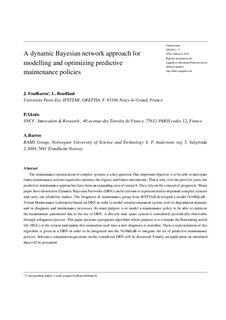| dc.contributor.author | Foulliaron, Josquin | |
| dc.contributor.author | Bouillaut, Laurent | |
| dc.contributor.author | Aknin, Patrice | |
| dc.contributor.author | Barros, Anne | |
| dc.date.accessioned | 2018-04-13T13:23:11Z | |
| dc.date.available | 2018-04-13T13:23:11Z | |
| dc.date.created | 2017-10-25T13:25:27Z | |
| dc.date.issued | 2017 | |
| dc.identifier.citation | Proceedings of the Institution of Mechanical Engineers. Part O, Journal of risk and reliability. 2017, 231 (5), 516-533. | nb_NO |
| dc.identifier.issn | 1748-006X | |
| dc.identifier.uri | http://hdl.handle.net/11250/2494098 | |
| dc.description.abstract | The maintenance optimization of complex systems is a key question. One important objective is to be able to anticipate future maintenance actions required to optimize the logistic and future investments. That is why, over the past few years, the predictive maintenance approaches have been an expanding area of research. They rely on the concept of prognosis. Many papers have shown how dynamic Bayesian networks can be relevant to represent multicomponent complex systems and carry out reliability studies. The diagnosis and maintenance group from French institute of science and technology for transport, development and networks (IFSTTAR) developed a model (VirMaLab: Virtual Maintenance Laboratory) based on dynamic Bayesian networks in order to model a multicomponent system with its degradation dynamic and its diagnosis and maintenance processes. Its main purpose is to model a maintenance policy to be able to optimize the maintenance parameters due to the use of dynamic Bayesian networks. A discrete state-space system is considered, periodically observable through a diagnosis process. Such systems are common in railway or road infrastructure fields. This article presents a prognosis algorithm whose purpose is to compute the remaining useful life of the system and update this estimation each time a new diagnosis is available. Then, a representation of this algorithm is given as a dynamic Bayesian network in order to be next integrated into the Virtual Maintenance Laboratory model to include the set of predictive maintenance policies. Inference computation questions on the considered dynamic Bayesian networks will be discussed. Finally, an application on simulated data will be presented. | nb_NO |
| dc.language.iso | eng | nb_NO |
| dc.publisher | SAGE Publications | nb_NO |
| dc.title | A dynamic Bayesian network approach for prognosis computations on discrete state systems | nb_NO |
| dc.type | Journal article | nb_NO |
| dc.description.version | submittedVersion | nb_NO |
| dc.source.pagenumber | 516-533 | nb_NO |
| dc.source.volume | 231 | nb_NO |
| dc.source.journal | Proceedings of the Institution of Mechanical Engineers. Part O, Journal of risk and reliability | nb_NO |
| dc.source.issue | 5 | nb_NO |
| dc.identifier.doi | 10.1177/1748006X17712661 | |
| dc.identifier.cristin | 1507607 | |
| dc.description.localcode | © 2017. This is the authors' manuscript to the article. The final authenticated version is available online at: http://journals.sagepub.com/doi/10.1177/1748006X17712661 | nb_NO |
| cristin.unitcode | 194,64,92,0 | |
| cristin.unitname | Institutt for maskinteknikk og produksjon | |
| cristin.ispublished | true | |
| cristin.fulltext | preprint | |
| cristin.qualitycode | 1 | |
